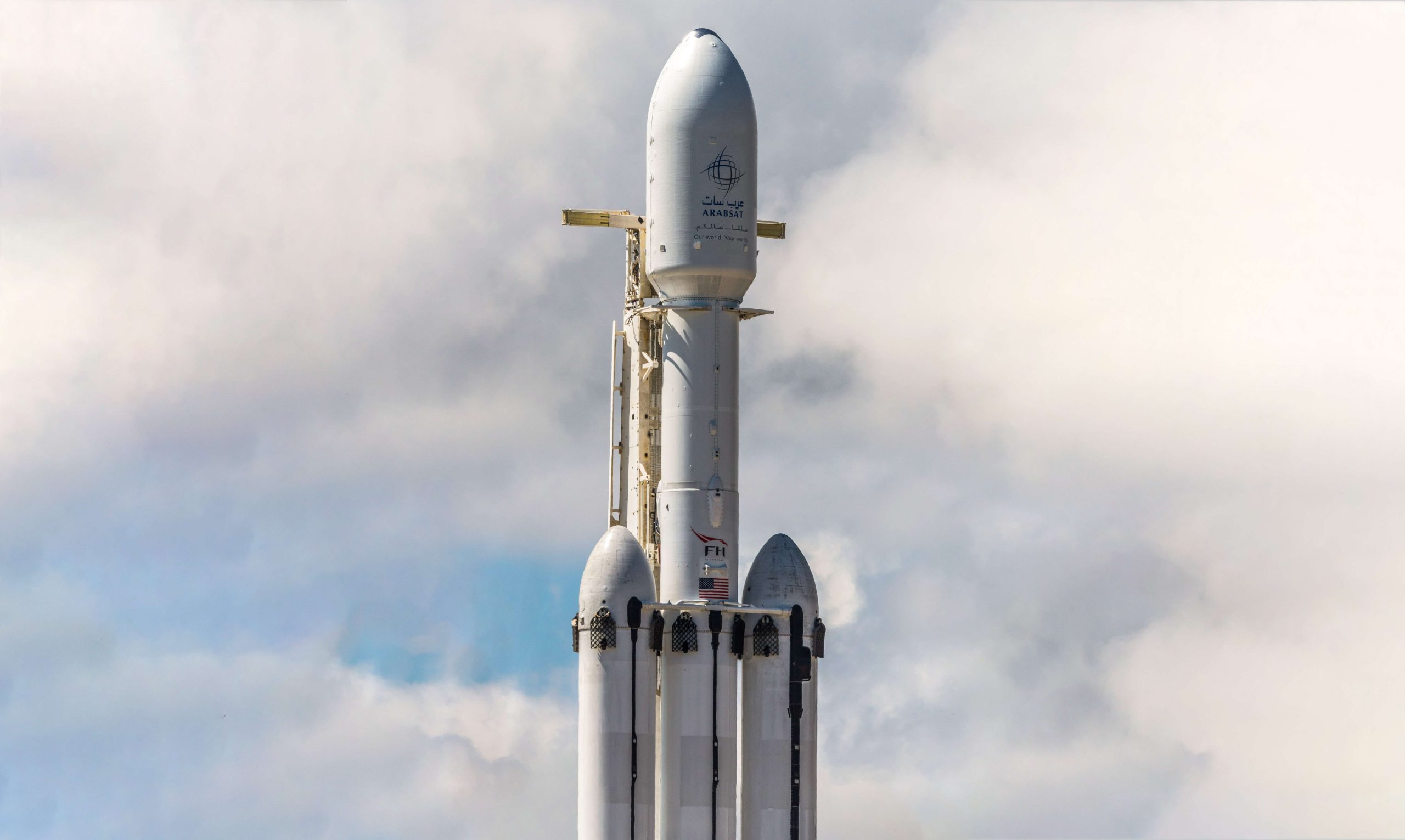
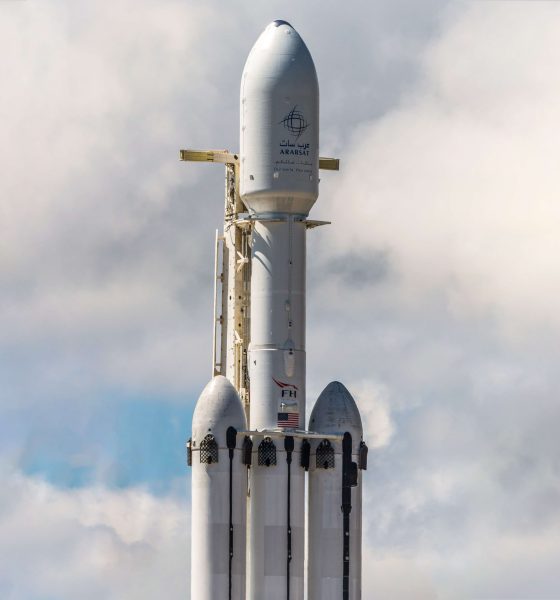
News
SpaceX’s next commercial Falcon Heavy launch to carry Astranis rideshare satellite
Geostationary satellite communications startup Astranis has decided to move its first operational satellite launch from a SpaceX Falcon 9 to a Falcon Heavy, effectively securing the massive rocket its first commercial rideshare payload.
While not technically Falcon Heavy’s first rideshare payload and not the rocket’s first commercial rideshare launch contract, Astranis’ first 400 kg (~900 lb) MicroGEO satellite nevertheless appears set to become the first commercial rideshare payload to actually fly on the world’s largest operational rocket. Not all that dissimilar to Starlink in scope and its desire to disrupt a stagnant industry, Astranis wants to offer global communications services providers a different route to geostationary internet and broadcast solutions. Unlike SpaceX’s constellation, the startup’s MicroGEO satellites are designed for geostationary orbits ~36,000 km (~22,200 mi) above Earth’s surface and more than 60 times higher than Starlink.
However, like Starlink satellites, MicroGEO will feature exceptional density (throughput per kilogram), weighing a magnitude less than average modern geostationary communications satellites while still offering up to 10 Gbps of bandwidth. Expected to cost around $40M apiece compared to ~$100M+ for most traditional offerings, the value proposition of small Astranis satellites with 5-10 times less bandwidth admittedly gets a bit blurrier, but the company should still offer a viable alternative for companies and countries that just don’t need a massive satellite.
For example, Astranis’ first customer and the buyer behind the first MicroGEO satellite – known as Aurora 4A – is Pacific Dataport, a company focused on delivering connectivity throughout Alaska – one of the most remote and sparsely populated places on Earth. That combination of attributes makes providing broadband communication services spectacularly difficult and satellite internet the perfect (and, to an extent, the only viable) solution. However, a full $100M+ geostationary communications satellite with 50-100+ Gbps of bandwidth would likely far outweigh the needs of Alaska’s ~730,000 residents – especially when most Alaskans live in the state’s few large cities, most of which already have passable internet connectivity.
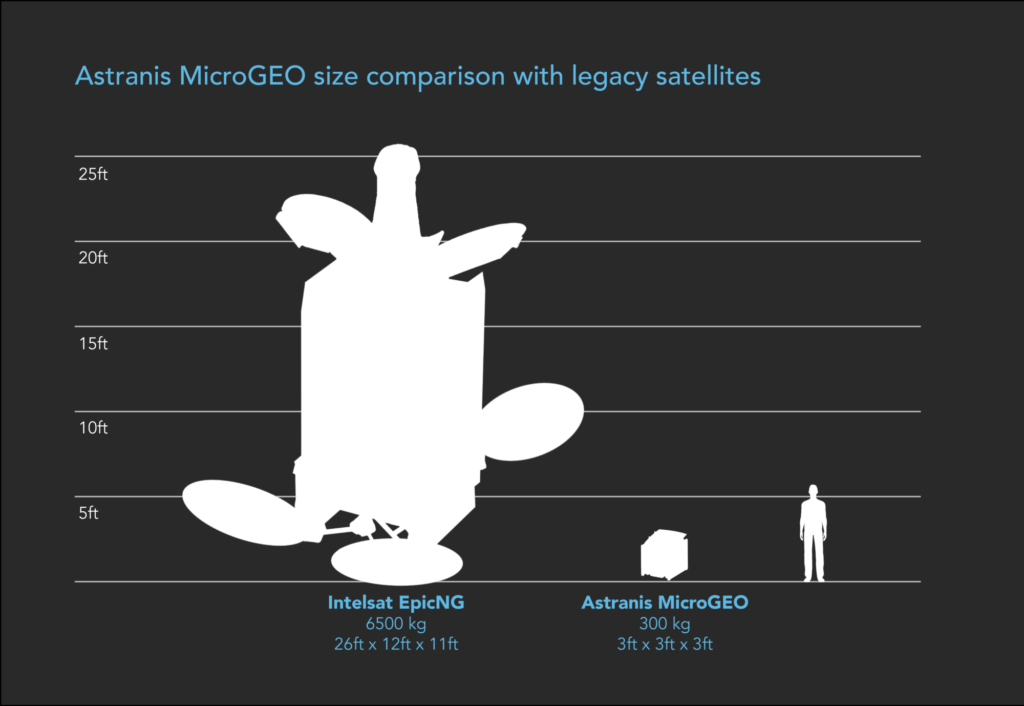
As such, it’s easy to see why a small but high-performance geostationary satellite like the kind Astranis offers might be a perfect fit for an Alaskan internet provider. While low Earth orbit (LEO) constellations like OneWeb and SpaceX’s Starlink do offer far more bandwidth and a user experience potentially as good or better than a wired connection almost anywhere on Earth, both companies first have to launch hundreds or thousands of satellites to ensure continuous coverage. Both Starlink and OneWeb are a ways away from offering continuous coverage in polar regions.
Geostationary satellites – especially those as small as Aurora 4A – offer a significant shortcut, requiring just a single satellite and ground stations in one or a few very specific regions to fully complete a communications network. Of course, thanks to universal limits posed by the speed of light, geostationary internet customers end up saddled with extreme latency (ping on the order of 300-1000ms) and strict individual bandwidth limits. But in places like Alaska, where there can easily be no alternative for the most rural residents, Astranis – or just about anything – could bring welcome relief.
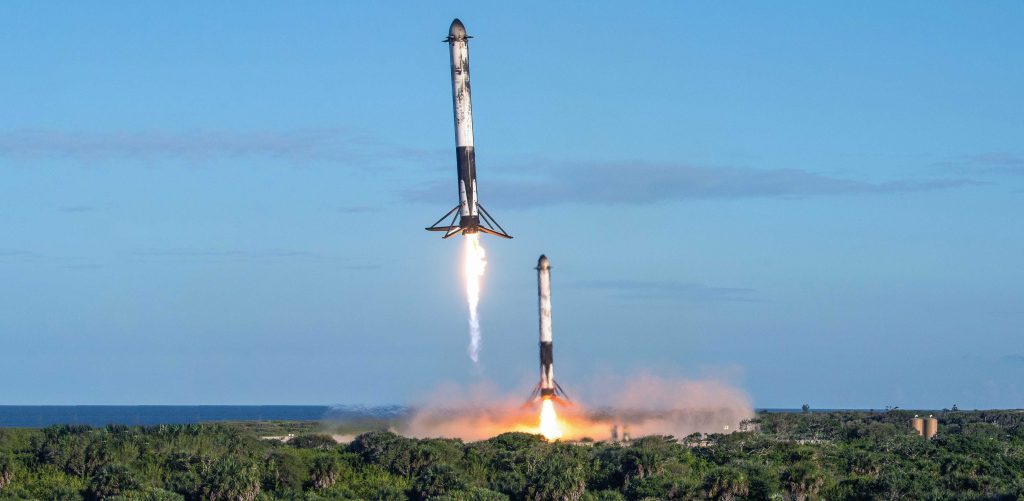
Now, Astranis says it has moved the first MicroGEO satellite from a SpaceX Falcon 9 rocket to rideshare payload on Falcon Heavy’s upcoming ViaSat-3 launch, scheduled no earlier than Q2 2022. According to the startup, doing so will allow the tiny satellite to begin operations over Alaska mere days or a few weeks after launch, saving months of orbit-raising thanks to Falcon Heavy’s performance. That’s only possible because, as the Astranis press release also revealed, Falcon Heavy is scheduled to launch the 6.4 ton (~14,100 lb) ViaSat-3 and 400 kg (~900 lb) Aurora 4A satellites directly to geostationary orbit (GEO). If Falcon Heavy’s upcoming USSF-44 mission launches on schedule next month, ViaSat-3 will be SpaceX’s second direct-to-GEO mission ever and the company’s first for a commercial customer.
Assuming SpaceX is still able to recover two – or even all three – of Falcon Heavy’s side boosters while launching almost 7 tons (~15,500 lb) of satellites directly to GEO, it will also demonstrate just how much of a force to be reckoned with it really is, well and truly leaving competitors ULA and Arianespace with nowhere to hide on the open market.

Elon Musk
NVIDIA CEO Jensen Huang commends Tesla’s Elon Musk for early belief
“And when I announced DGX-1, nobody in the world wanted it. I had no purchase orders, not one. Nobody wanted to buy it. Nobody wanted to be part of it, except for Elon.”
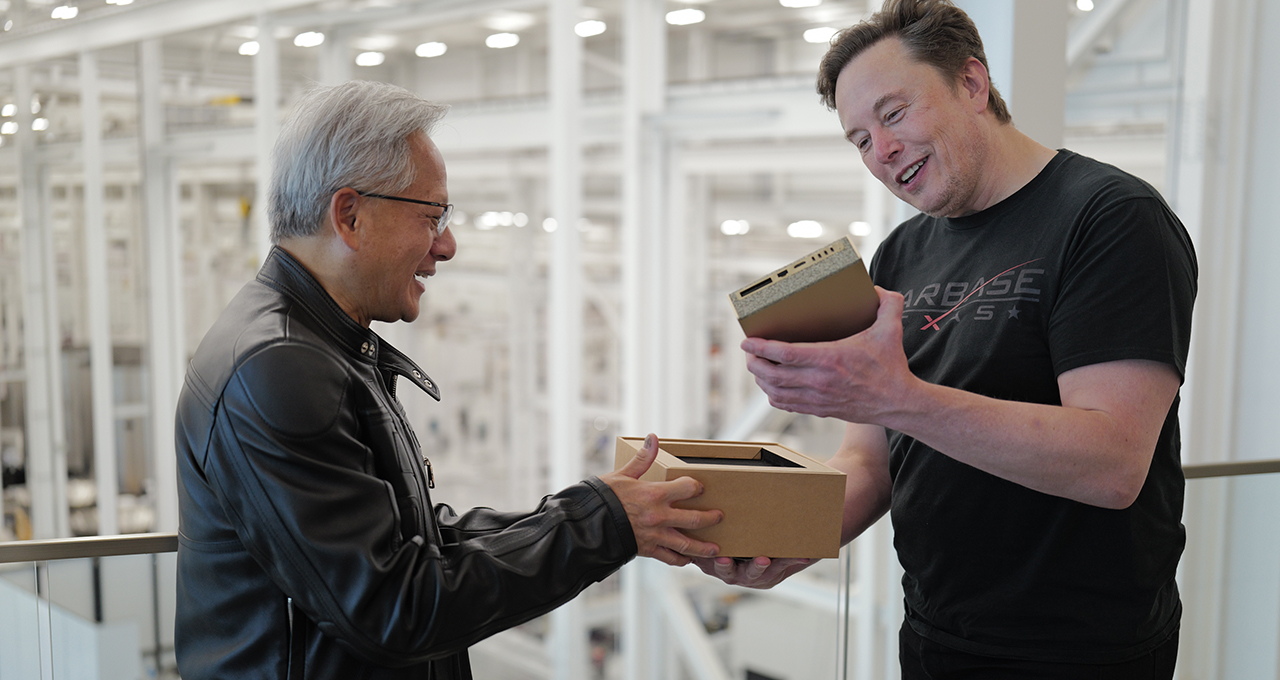
NVIDIA CEO Jensen Huang appeared on the Joe Rogan Experience podcast on Wednesday and commended Tesla CEO Elon Musk for his early belief in what is now the most valuable company in the world.
Huang and Musk are widely regarded as two of the greatest tech entrepreneurs of the modern era, with the two working in conjunction as NVIDIA’s chips are present in Tesla vehicles, particularly utilized for self-driving technology and data collection.
Nvidia CEO Jensen Huang regrets not investing more in Elon Musk’s xAI
Both CEOs defied all odds and created companies from virtually nothing. Musk joined Tesla in the early 2000s before the company had even established any plans to build a vehicle. Jensen created NVIDIA in the booth of a Denny’s restaurant, which has been memorialized with a plaque.
On the JRE episode, Rogan asked about Jensen’s relationship with Elon, to which the NVIDIA CEO said that Musk was there when nobody else was:
“I was lucky because I had known Elon Musk, and I helped him build the first computer for Model 3, the Model S, and when he wanted to start working on an autonomous vehicle. I helped him build the computer that went into the Model S AV system, his full self-driving system. We were basically the FSD computer version 1, and so we were already working together.
And when I announced DGX-1, nobody in the world wanted it. I had no purchase orders, not one. Nobody wanted to buy it. Nobody wanted to be part of it, except for Elon.
He goes ‘You know what, I have a company that could really use this.’ I said, Wow, my first customer. And he goes, it’s an AI company, and it’s a nonprofit and and we could really use one of these supercomputers. I boxed one up, I drove it up to San Francisco, and I delivered it to the Elon in 2016.”
The first DGX-1 AI supercomputer was delivered personally to Musk when he was with OpenAI, which provided crucial early compute power for AI research, accelerating breakthroughs in machine learning that underpin modern tools like ChatGPT.
Tesla’s Nvidia purchases could reach $4 billion this year: Musk
The long-term alliance between NVIDIA and Tesla has driven over $2 trillion in the company’s market value since 2016.
Elon Musk
GM CEO Mary Barra says she told Biden to give Tesla and Musk EV credit
“He was crediting me, and I said, ‘Actually, I think a lot of that credit goes to Elon and Tesla…You know me, Andrew. I don’t want to take credit for things.”

General Motors CEO Mary Barra said in a new interview on Wednesday that she told President Joe Biden to credit Tesla and its CEO, Elon Musk, for the widespread electric vehicle transition.
She said she told Biden this after the former President credited her and GM for leading EV efforts in the United States.
During an interview at the New York Times Dealbook Summit with Andrew Ross Sorkin, Barra said she told Biden that crediting her was essentially a mistake, and that Musk and Tesla should have been explicitly mentioned (via Business Insider):
“He was crediting me, and I said, ‘Actually, I think a lot of that credit goes to Elon and Tesla…You know me, Andrew. I don’t want to take credit for things.”
GM CEO Mary Barra said to Andrew Sorkin at the New York Times Dealbook Summit that she pulled President Biden aside and said Tesla CEO @elonmusk deserved the credit for EVs:
“He was crediting me, and I said, ‘Actually, I think a lot of that credit goes to Elon and Tesla,'” Barra… pic.twitter.com/OHBTG1QfbJ
— TESLARATI (@Teslarati) December 3, 2025
Back in 2021, President Biden visited GM’s “Factory Zero” plant in Detroit, which was the centerpiece of the company’s massive transition to EVs. The former President went on to discuss the EV industry, and claimed that GM and Barra were the true leaders who caused the change:
“In the auto industry, Detroit is leading the world in electric vehicles. You know how critical it is? Mary, I remember talking to you way back in January about the need for America to lead in electric vehicles. I can remember your dramatic announcement that by 2035, GM would be 100% electric. You changed the whole story, Mary. You did, Mary. You electrified the entire automotive industry. I’m serious. You led, and it matters.”
People were baffled by the President’s decision to highlight GM and Barra, and not Tesla and Musk, who truly started the transition to EVs. GM, Ford, and many other companies only followed in the footsteps of Tesla after it started to take market share from them.
Elon Musk and Tesla try to save legacy automakers from Déjà vu
Musk would eventually go on to talk about Biden’s words later on:
“They have so much power over the White House that they can exclude Tesla from an EV Summit. And, in case the first thing, in case that wasn’t enough, then you have President Biden with Mary Barra at a subsequent event, congratulating Mary for having led the EV revolution.”
In Q4 2021, which was shortly after Biden’s comments, Tesla delivered 300,000 EVs. GM delivered just 26.
News
Tesla Full Self-Driving shows confident navigation in heavy snow
So far, from what we’ve seen, snow has not been a huge issue for the most recent Full Self-Driving release. It seems to be acting confidently and handling even snow-covered roads with relative ease.

Tesla Full Self-Driving is getting its first taste of Winter weather for late 2025, as snow is starting to fall all across the United States.
The suite has been vastly improved after Tesla released v14 to many owners with capable hardware, and driving performance, along with overall behavior, has really been something to admire. This is by far the best version of FSD Tesla has ever released, and although there are a handful of regressions with each subsequent release, they are usually cleared up within a week or two.
Tesla is releasing a modified version of FSD v14 for Hardware 3 owners: here’s when
However, adverse weather conditions are something that Tesla will have to confront, as heavy rain, snow, and other interesting situations are bound to occur. In order for the vehicles to be fully autonomous, they will have to go through these scenarios safely and accurately.
One big issue I’ve had, especially in heavy rain, is that the camera vision might be obstructed, which will display messages that certain features’ performance might be degraded.
So far, from what we’ve seen, snow has not been a huge issue for the most recent Full Self-Driving release. It seems to be acting confidently and handling even snow-covered roads with relative ease:
FSD 14.1.4 snow storm Ontario Canada pic.twitter.com/jwK1dLYT0w
— Everything AI (@mrteslaspace) November 17, 2025
I found the steepest, unplowed hill in my area and tested the following:
• FSD 14.2.1 on summer tires
• FSD 14.2.1 on winter tires
• Manual drivingBut I think the most impressive part was how FSD went DOWN the hill. FSD in the snow is sublime $TSLA pic.twitter.com/YMcN7Br3PU
— Dillon Loomis (@DillonLoomis) December 2, 2025
Well.. I couldn’t let the boys have all the fun!
Threw the GoPro up and decided to FSD v14.2.1 in the snow. Roads were not compacted like the other day, a little slippery, but overall doable at lower speeds. Enjoy the video and holiday music 🎶
Liked:
Took turns super slow… pic.twitter.com/rIAIeh3Zu3— 🦋Diana🦋 (@99_Colorado) December 3, 2025
Moving into the winter months, it will be very interesting to see how FSD handles even more concerning conditions, especially with black ice, freezing rain and snow mix, and other things that happen during colder conditions.
We are excited to test it ourselves, but I am waiting for heavy snowfall to make it to Pennsylvania so I can truly push it to the limit.








